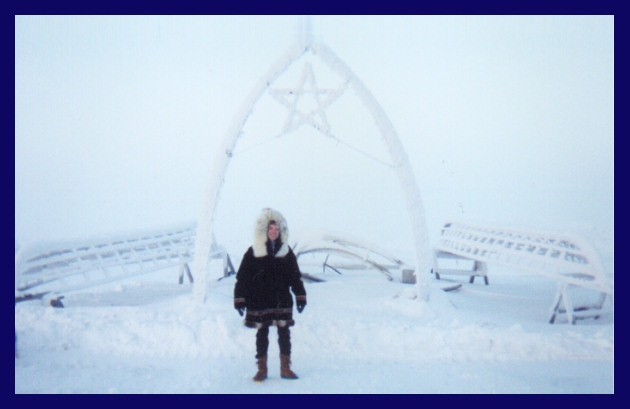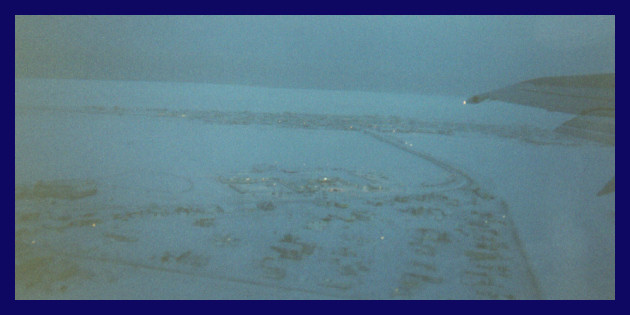Home on the Ice
I visited Barrow, Alaska, about 350 miles north of the Arctic circle, from February 2-5, 2002, to give some astronomy lectures at schools. The timing of my visit coincided (roughly) with the return of the Sun to Barrow on January 24 after two months below the horizon. This all came about because one of the longtime Friends of Lowell worked at KBRW "Top of the World radio," and he had arranged for some scientists to come talk to the kids there. I was lucky enough to be one of the ones invited!
It took about twelve hours to fly from Phoenix to Seattle, Anchorage, Fairbanks, and then on to Barrow on Alaska Airlines. We arrived on a spectacular approach over the Chugach mountains into Anchorage, where it was about 25 F. I had never been this far north (about the same latitude as Helsinki), and the endless yellow afternoon light on the surrounding mountains was beautiful. Almost as impressive was the enormous stuffed polar bear decorating the Anchorage terminal. After a two hour layover, we went on to Fairbanks in an old 737-200 combi -- passengers in the back half, a bulkhead over the wings, and cargo forward. We flew right by Denali, and I saw a few dog mushers on the approach into Fairbanks, where it was a brisk -8 F. Finally, we went on to Barrow, an 80 minute flight northwest out of Fairbanks. Twilight was fading as we reached the Brooks range, and I saw a few lonely lights were scattered across the land, impossibly cold and remote. I smiled when the flight attendent came around with the in-flight meal; after flying a full day north out of Arizona, heading over the tundra, I was served -- a burrito!
The approach to runway 6 at Barrow was unnerving. We descended, turned, descended, slats and flaps extended, all the usual preparations for landing -- but there was pure darkness out the window. Somewhere out there was the Arctic Ocean. At last, with my cheek pressed on the window, I saw a cluster of yellow lights ahead. Just before we landed, the town came into view, and for a moment, I had to think Dante was right. Near the airport were one-story huts covered with ice, steam whipping from their roof vents in a stiff east wind. Ice covered the telephone poles, the wires, walls, roofs, cars, windows...everything. Ramp workers at the airport were so heavily clothed they looked like robots. The plane was bumping around in earnest, and we landed with a thud on a white runway.
It was -34 F with a 20 knot wind. The wind chill in such conditions is not rewarding to calculate. There was no jetway; we climbed down a stairway at the back of the plane and walked across the ramp to the terminal. I had enough layers to get that far, but with only a basic sweatshirt hood to protect my face, taking a breath was almost painful. My hosts had brought an extra parka, correctly anticipating that I would be underdressed.

This is where I stayed; a typical Barrow house. The walls are more than a foot thick. Like every structure in Barrow, it's on stilts so it won't melt the permafrost. Unlike many houses, it has an apron to keep the extreme cold out of the understructure. Power and running water are supplied via the "Utilidor," a deeply buried trench, constructed at grievous expense, running through the town and bringing utilities straight up into the houses from underneath. Not all residences are hooked up to this. It was quite cozy inside the well-insulated residence -- about 80 degrees in the guest bedroom. It was amusing to stick one's head out the door just to experience a temperature differential of 110 degrees!
For most of the time I was in Barrow, I never saw the sky. The relentless east wind had stirred a ground blizzard across the tundra, and although it was clear, there was about a 200 foot thick layer of snow and ice blowing through town. Flights the day after I arrived were cancelled, and visibility at times was near zero. The sun rose at about 11 in the morning, and set around 1:30. It was completely dark from maybe 4:30 PM until about 9 in the morning, when a slow twilight began to creep up in the southeast.
On Sunday morning, the storm had abated enough that I could see the waning half moon. It was right on the horizon, with the terminator straight up and down. I had to think about that for a bit before I correctly visualized the Sun-Moon-Earth geometry from my unusual vantage point. The Moon was nearly circumpolar; throughout the morning it scooted along the horizon, finally setting a few hours later. It was a useful lesson: you can study things all your life, understand them conceptually, but there's nothing like experience to bring it home.
I took advantage of the odd-looking Moon later that morning. I had agreed to speak briefly to the Eskimo children at a church service, and I talked to them about the sky. I told them how the Sun goes high up to the top of the heavens in Arizona, and shines with intense warmth even on winter days. The wonder on their faces was exactly what I was looking for. I was feeling just the same way, I told them; I never see the moon the way it looked that morning, it had confused me for a minute, and if you just go out and explore, creation will never cease to surprise you. It's very true, as long as you're not so jaded by intellectualism that the world is a dreary automaton.

A typical view in Barrow, with the Sun trying mightily to shine through the gale. Here I was on my way to talk to the kids at the middle school, at about 12:30 in the afternoon.

The Sunday church service lasted about two hours, mainly because everything was done twice, once in English and once in Inupiat. During the service, we left the car outside, unlocked, keys in the ignition and engine running, so the engine wouldn't freeze. There was no risk of theft; with the nearest non-local road some 300 miles away, where, after all, would a thief go? After the service, we went to the "beach," where my hosts took this picture of me in front of a defining Barrow landmark: whaleboats and bones below the north star. It was about -20, with more of that east wind (right to left in the photo) whipping by. The sky looks white because it's filled with snow and ice. Beyond this is just 900 miles of ice to the North Pole. The parka is borrowed, and it worked very well. I did have one bit of dress satisfaction; a few years before my trip, my in-laws had given me a pair of Steger mukluks, which I am wearing in the picture. They performed admirably and were complimented several times by the locals, one of whom remarked that "so-and-so went to the Pole in those." So for four frigid days, at least my feet were warm!
We did get a chance to drive out towards Point Barrow one night to see the aurora. My host advised me to not get far from the car, explaining that polar bears were hard to see in the blowing snow. Wonderful. The visibility was just enough to see Polaris almost directly above, and a nice green aurora obligingly appeared shortly after we got out of the car. I was hesitant to leave the car and close the door so the dome light would go out, while leaving the keys inside and the engine still running. If we locked ourselves out, we would die. It was that simple.

A nice guy took this picture of me about to leave on February 5. This was about 10:25 in the morning, and the temperature had moderated to a balmy -5. By this point, I didn't think twice about that! The stairway into the plane is visible; beyond it are a few hundred miles of North Slope tundra.

A birds-eye view on departure. Clusters of houses are interspersed with Arctic lagoons. At top is the Arctic Ocean. The huge structure at center is one of the impressive schools.
Barrow is a civic Jekyll and Hyde. Everywhere are desperately weatherbeaten structures. Broken appliances and dead cars are strewn about the tiny lots, along with frozen whale meat. There are no paved roads. The population is primarily the hardy Inupiat, who pursue a subsistence lifestyle centered on annual whaling expeditions in handmade boats (which I had a chance to observe some of the men constructing). The cost of living is perhaps understandably outrageous -- small pads of paper were selling for $4, and food prices were stratospheric.
The town seems a dump, and hopelessly at the mercy of brutal weather, until you look closer and the money coursing through this little place at the end of the world becomes apparent. The schools are almost opulent; they'd be the envy of any school here in Flagstaff. They have state of the art classrooms, supplies, fast Internet, top-notch A/V equipment, huge, spacious corridors and rooms, exceptionally well-equipped labs and gymnasiums. And the Inupiat Heritage Center, where I gave my public lecture, is a beautiful museum, with numerous exhibits describing the history of the region, a full-scale model of a bowhead whale suspended in the lobby, and a comfortable, well-appointed auditorium.
The money, of course, flows from the oil at Prudhoe Bay, far down the coast to the east, and from the rather complex settlement originally formed between the Nixon administration and the Alaskan natives that has pumped a huge amount of money into the communities of the North Slope, as well as transformed the politics and governance of the area. I'm not sure I ever figured out the interplay between the City of Barrow, the Native Village of Barrow, and the North Slope Borough, a consortium of a handful of tiny communities spread across a region the size of Minnesota, which was created as part of Alaskan Native Land Claims Settlement Act of 1971, and which evidently wields the real power in the area.
I couldn't live in Barrow; I'm an Arizona winter wimp and I love my sunshine. But I remember wondering about it when I was 10, looking at maps of Alaska, trying to imagine what could possibly be in that tiny place at the tip of a continent. Twenty-seven years later, I made it there, taxiing in to the terminal with ice blowing furiously past the window, feeling very much a stranger in a strange land, and thinking to myself: "Where in the hell am I?" Just then, a few rows ahead of me, a father picked up a small boy, ruffled his hair, and said, "We're home." For the next two days, so was I.
[ Back to my home page ]